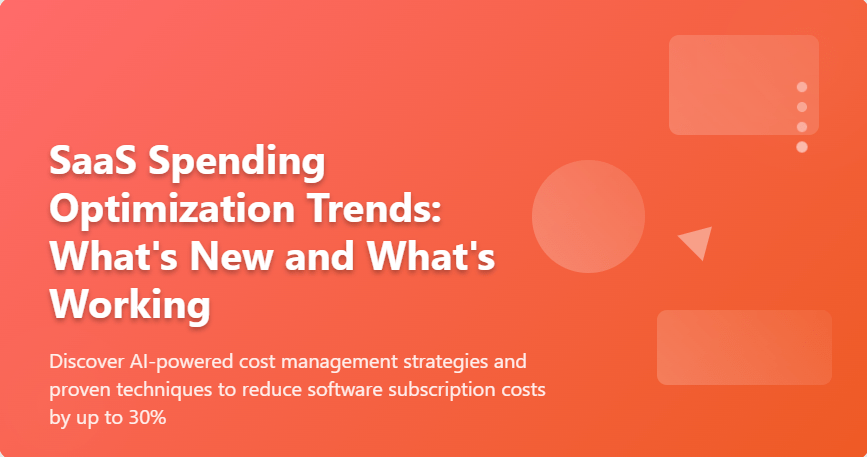
As we advance through 2025, the landscape of SaaS spending optimization continues to evolve at an unprecedented pace. Organizations worldwide are grappling with increasingly complex software ecosystems while seeking innovative ways to control costs and maximize value from their technology investments.
The traditional approaches to SaaS cost management are being transformed by cutting-edge technologies and methodologies that promise not just cost reduction, but intelligent resource allocation and predictive spending optimization. Companies that once relied on manual tracking and periodic audits are now embracing automated, AI-driven solutions that provide real-time insights and proactive cost management capabilities.
This comprehensive guide examines the most significant trends shaping SaaS spending optimization in 2025, exploring both revolutionary new approaches and refined strategies that continue to deliver results.
The Current State of SaaS Spending in 2025
The SaaS market has reached unprecedented levels of maturity and complexity in 2025. According to the latest industry reports, global SaaS spending has surpassed $650 billion annually, representing a significant increase from previous years. This growth reflects not just market expansion, but also the deepening integration of cloud computing solutions across all business sectors.
Organizations now manage an average of 130 SaaS applications, a substantial increase from the 80 applications reported just three years ago. This explosion in software adoption has created both opportunities and challenges for IT departments and financial teams responsible for cost optimization.
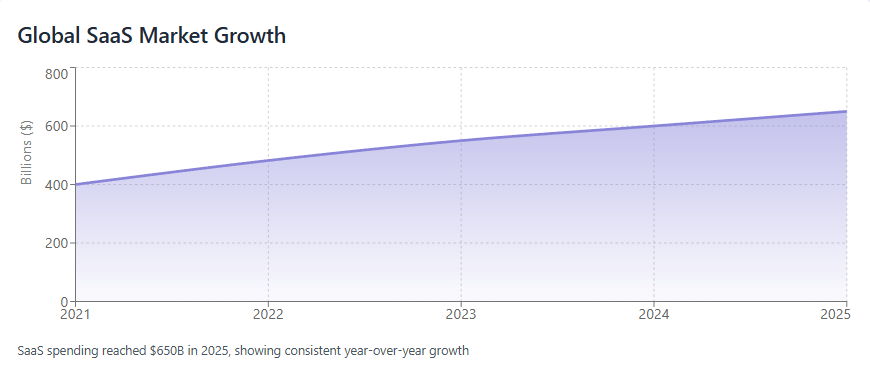
Key Spending Patterns in 2025
The distribution of SaaS spending has shifted dramatically:
- Productivity and Collaboration Tools continue to dominate spending, accounting for approximately 35% of total SaaS budgets. The hybrid work model has solidified the importance of comprehensive collaboration platforms.
- Security and Compliance Solutions have seen explosive growth, now representing 22% of average SaaS budgets. With increasing regulatory requirements and sophisticated cyber threats, organizations are prioritizing robust security infrastructure.
- Industry-Specific Applications have gained significant traction, comprising 18% of spending. Vertical SaaS solutions tailored to specific industries offer specialized functionality but often come with premium pricing.
- Analytics and Business Intelligence platforms account for 15% of budgets, reflecting the growing demand for data-driven decision making across all business functions.
Cost Management Challenges
Despite increased awareness of SaaS spending optimization, organizations continue to face significant challenges:
- Shadow IT Proliferation remains a persistent issue, with departments independently procuring SaaS solutions without centralized oversight. Studies indicate that up to 40% of SaaS applications in use are not officially sanctioned or tracked by IT departments.
- License Optimization Complexity has grown as vendors introduce increasingly sophisticated pricing models. Subscription tiers, usage-based pricing, and feature-specific add-ons create complex optimization scenarios.
- Multi-Vendor Management presents ongoing difficulties as organizations struggle to maintain visibility across dozens or hundreds of vendor relationships, each with unique contract terms, renewal cycles, and pricing structures.
What’s New: Emerging Trends in SaaS Cost Optimization
Predictive Cost Analytics
One of the most significant developments in 2025 is the emergence of predictive cost analytics powered by machine learning algorithms. These systems analyze historical usage patterns, seasonal trends, and business growth indicators to forecast future SaaS spending with remarkable accuracy.
Advanced cloud management strategies now incorporate predictive modeling that can anticipate cost spikes before they occur, allowing organizations to proactively adjust their subscriptions or negotiate better terms with vendors.
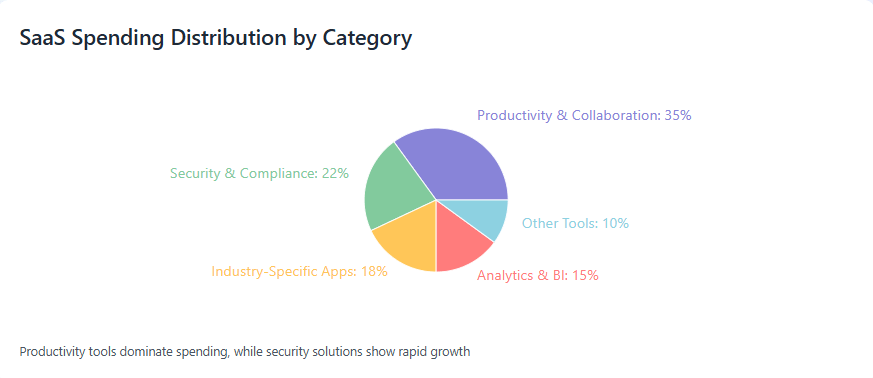
Zero-Trust SaaS Architecture
The zero-trust security model has extended into SaaS cost optimization, creating new approaches to application access and licensing. Organizations are implementing just-in-time access provisioning for SaaS applications, ensuring that users only have access to the tools they actively need for specific projects or time periods.
This approach not only enhances security but also optimizes licensing costs by eliminating permanently assigned licenses for intermittent users. The result is a more dynamic, cost-effective approach to SaaS provisioning that can reduce licensing costs by 20-30% in many organizations.
Automated Vendor Negotiation
AI-powered procurement platforms are now capable of automatically negotiating with SaaS vendors based on usage data, market pricing intelligence, and contract terms analysis. These systems can identify optimal renewal timing, negotiate volume discounts, and even switch between comparable services to achieve cost savings.
The technology leverages natural language processing and machine learning to engage with vendor sales teams, following pre-defined negotiation strategies while escalating complex decisions to human procurement specialists.
Real-Time Usage Optimization
Modern SaaS optimization platforms now provide real-time usage monitoring with automated right-sizing recommendations. These systems continuously analyze user activity across all connected applications and can automatically adjust subscription levels, disable unused features, or recommend alternative pricing tiers.
The granularity of monitoring has improved significantly, with some platforms tracking individual feature usage within applications to identify opportunities for more targeted licensing strategies.
AI-Powered SaaS Management Solutions
Artificial intelligence has become the cornerstone of modern SaaS spending optimization, transforming how organizations approach cost management and resource allocation. The integration of AI technologies has moved beyond simple automation to provide sophisticated insights and decision-making capabilities.
Machine Learning for Usage Prediction
Advanced machine learning algorithms now analyze complex patterns in SaaS usage to predict future needs with unprecedented accuracy. These systems consider multiple variables including seasonal business cycles, team growth projections, project timelines, and historical usage trends to forecast optimal licensing requirements.
The predictive capabilities extend to identifying which users are likely to become power users requiring premium features, which applications may become redundant due to changing business processes, and when temporary license increases may be needed for specific projects.
Natural Language Processing for Contract Analysis
AI-powered contract analysis tools have revolutionized how organizations manage their SaaS vendor relationships. Natural language processing engines can automatically review contract terms, identify renewal clauses, extract pricing information, and flag potentially problematic terms or opportunities for renegotiation.
These systems maintain comprehensive databases of contract terms across the entire SaaS portfolio, enabling organizations to identify patterns, benchmark pricing against industry standards, and optimize renewal strategies across multiple vendors simultaneously.
Intelligent Anomaly Detection
Modern AI systems excel at identifying unusual spending patterns or usage anomalies that may indicate optimization opportunities or potential issues. These platforms can detect sudden spikes in usage that might indicate the need for different pricing tiers, identify applications with declining usage that may be candidates for elimination, and spot potential security issues through unusual access patterns.
The anomaly detection capabilities have become sophisticated enough to distinguish between legitimate business-driven changes and potential waste or security concerns, reducing false positives while ensuring genuine optimization opportunities are quickly identified.
What’s Working: Proven Optimization Techniques
While emerging technologies capture attention, several established optimization techniques continue to deliver consistent results for organizations of all sizes. These proven strategies form the foundation of successful SaaS cost management programs.
Centralized Procurement and Governance
Organizations that have implemented centralized SaaS procurement processes continue to see significant cost savings and improved vendor management. Centralized procurement enables better vendor relationship management, improved contract negotiation leverage, and more effective elimination of redundant subscriptions.
The most successful implementations combine centralized oversight with distributed decision-making authority, allowing business units to select appropriate solutions while maintaining central visibility and control over spending and contract terms.
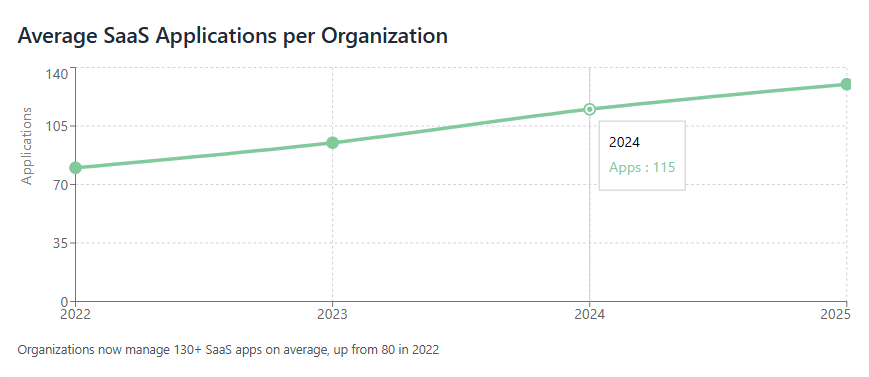
Regular Usage Auditing and Right-Sizing
Systematic auditing of SaaS usage remains one of the most effective optimization techniques, consistently identifying opportunities for subscription adjustments, feature optimization, and application consolidation. Organizations that conduct quarterly usage reviews typically achieve 15-25% cost reductions within the first year.
The key to successful auditing lies in implementing automated data collection processes that provide comprehensive visibility into actual usage patterns rather than relying on user self-reporting or manual tracking methods.
Strategic Vendor Consolidation
Consolidating similar functionality across fewer vendors continues to provide significant cost savings and operational efficiencies. Organizations that successfully consolidate their SaaS portfolios typically achieve better pricing through volume discounts, reduced administrative overhead, and improved integration capabilities.
The most effective consolidation strategies balance cost savings with functionality requirements, ensuring that consolidation efforts don’t compromise essential business capabilities or user productivity.
Lifecycle Management Automation
Implementing automated processes for user onboarding and offboarding has proven highly effective for controlling SaaS costs while improving security and compliance. Automated lifecycle management ensures that licenses are provisioned promptly when needed and deprovisioned immediately when users leave the organization or change roles.
Organizations with mature lifecycle management processes typically see 10-20% reductions in unnecessary licensing costs while improving their security posture and compliance status.
Best Practices for Modern SaaS Budget Management
Effective SaaS budget management in 2025 requires a combination of strategic planning, technological tools, and operational processes that address the complexity of modern software ecosystems.
Implementing Comprehensive Visibility
The foundation of effective SaaS budget management is comprehensive visibility into all software subscriptions, usage patterns, and associated costs. This visibility must extend beyond officially sanctioned applications to include shadow IT and departmental subscriptions that may not be centrally managed.
Modern visibility solutions integrate with financial systems, identity management platforms, and application usage monitoring tools to provide real-time insights into SaaS spending and utilization across the entire organization.
Establishing Clear Governance Frameworks
Successful SaaS budget management requires clear governance frameworks that define roles, responsibilities, and processes for software procurement, usage monitoring, and cost optimization. These frameworks must balance central control with business unit autonomy to ensure that optimization efforts don’t impede business productivity.
The most effective governance frameworks include clear approval processes for new subscriptions, regular review cycles for existing applications, and defined criteria for evaluating alternative solutions or vendor changes.
Developing Strategic Vendor Relationships
Building strategic relationships with key SaaS vendors can provide significant advantages in terms of pricing, contract flexibility, and access to new features or services. Organizations that invest in developing these relationships often receive preferential pricing, extended payment terms, and early access to new capabilities.
Strategic vendor management includes regular business reviews, collaborative planning for future needs, and proactive communication about changing requirements or budget constraints.
Tools and Technologies Leading the Way
The SaaS optimization tool landscape has evolved significantly, with new platforms offering sophisticated capabilities that go far beyond simple subscription tracking. Modern SaaS management platforms integrate artificial intelligence, advanced analytics, and automation capabilities to provide comprehensive optimization solutions.
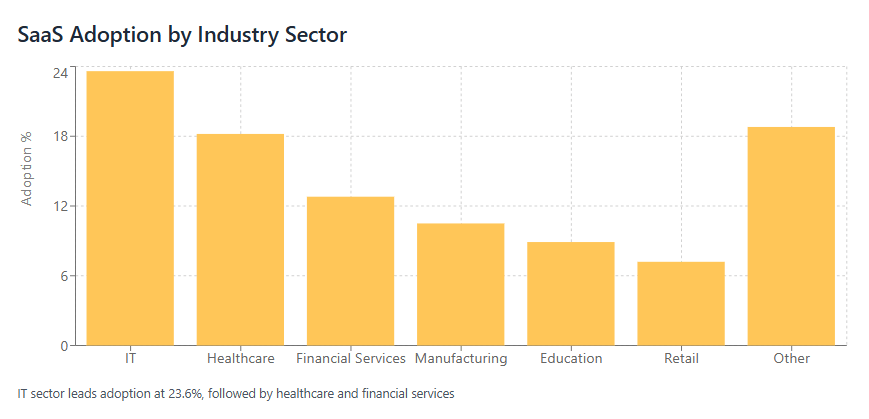
Next-Generation SaaS Management Platforms
The latest generation of SaaS management platforms offers integrated capabilities that combine discovery, optimization, governance, and automation in unified solutions. These platforms can automatically discover all SaaS applications in use across an organization, analyze usage patterns, and recommend optimization strategies based on comprehensive data analysis.
Leading platforms now include features such as automated contract analysis, predictive usage modeling, vendor benchmarking, and integrated procurement workflows that streamline the entire SaaS lifecycle management process.
Integration and Automation Tools
Modern SaaS optimization requires seamless integration with existing business systems including identity management, financial systems, and business applications. Advanced integration tools enable automated data collection, policy enforcement, and optimization implementation without manual intervention.
These integration capabilities extend to vendor systems, enabling automated communication with SaaS providers for tasks such as license adjustments, usage reporting, and contract management activities.
Binadox: Leading the SaaS Optimization Revolution
Among the platforms leading the SaaS optimization revolution, Binadox stands out for its comprehensive approach to both SaaS and cloud cost management. The platform offers integrated visibility across multi-cloud environments and SaaS applications, providing organizations with unified insights into their entire technology spending portfolio.
Binadox’s advanced analytics capabilities include automated usage monitoring, predictive cost modeling, and intelligent optimization recommendations that help organizations achieve significant cost savings while maintaining operational efficiency. The platform’s user-friendly interface and comprehensive reporting capabilities make it accessible to both technical and business stakeholders.
Key features that distinguish Binadox include automated license optimization, comprehensive vendor management capabilities, and sophisticated integration options that enable seamless incorporation into existing business processes. The platform’s AI-powered insights help organizations identify optimization opportunities that might otherwise go unnoticed.
Organizations using Binadox typically report significant improvements in SaaS cost visibility, substantial reductions in unnecessary spending, and improved vendor relationship management that leads to better contract terms and pricing arrangements.
Future Outlook: What to Expect
The SaaS optimization landscape will continue to evolve rapidly as new technologies mature and business requirements become increasingly sophisticated. Several trends are likely to shape the future of SaaS cost management and optimization strategies.
Advanced AI and Machine Learning Integration
Artificial intelligence and machine learning capabilities will become even more sophisticated, with platforms offering predictive optimization that can automatically adjust subscriptions based on forecasted usage patterns, market conditions, and business objectives. These systems will likely develop the ability to negotiate routine contract renewals autonomously while escalating complex decisions to human stakeholders.
Future AI systems may also incorporate sentiment analysis of user feedback and productivity metrics to optimize SaaS portfolios not just for cost, but for overall business value and user satisfaction.
Enhanced Integration Ecosystems
The future will likely see the development of more sophisticated integration ecosystems that enable seamless data sharing and process automation across diverse SaaS applications. These ecosystems will support more effective optimization by providing comprehensive visibility into how different applications interact and contribute to business processes.
Sustainability-Focused Optimization
Environmental sustainability will become an increasingly important factor in SaaS optimization decisions, with organizations considering the carbon footprint and environmental impact of their software choices alongside traditional cost and functionality criteria. Vendors will likely develop new metrics and reporting capabilities to support sustainability-focused decision making.
Conclusion
The landscape of SaaS spending optimization in 2025 represents a fascinating convergence of technological innovation and practical business necessity. Organizations are no longer content with basic subscription tracking and manual optimization processes; they demand sophisticated, AI-powered solutions that can automatically identify opportunities, predict future needs, and optimize costs while maintaining business functionality.
The trends we’ve explored—from predictive analytics and automated vendor negotiation to proven optimization strategies—demonstrate the rapid evolution of SaaS cost management capabilities. What’s particularly encouraging is that these advanced techniques are not replacing proven optimization strategies but rather enhancing and amplifying their effectiveness.
The future of SaaS spending optimization is bright, with continued innovation promising even more sophisticated and effective approaches to managing the complex software ecosystems that power modern businesses. Organizations that embrace these trends while maintaining focus on fundamental optimization principles will be well-positioned to maximize the value of their software investments while minimizing unnecessary costs.

